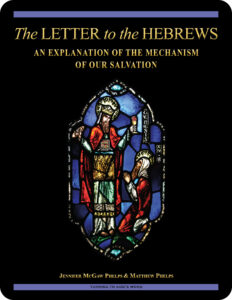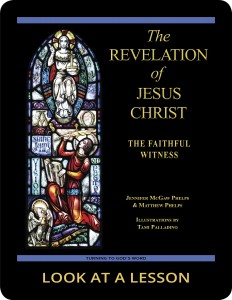 The Letter to the Hebrews:
The Letter to the Hebrews:
An Explanation of the Mechanism
of Our Salvation
Lesson 12 Let Us Draw Near with a True Heart
the Letter to the Hebrews 10:19–39
Revised Standard Version Catholic Edition (RSVCE)*
New American Bible Revised Edition (NABRE)*
Catechism of the Catholic Church
ex libris (in our library)
Tami Palladino’s visual-meditation journal
cross references in the Letter to the Hebrews
next lesson: By Faith, We Too Live
This material coordinates with Lesson 12 on pages 43–45 in The Letter to the Hebrews: An Explanation of the Mechanism of Our Salvation.
“In the days of his flesh, Jesus offered up prayers and supplications with loud cries and tears, to him who was able to save him from death, and he was heard for his godly fear. Although he was a Son, he learned obedience through what he suffered; and being made perfect he became the source of eternal salvation to all who obey him, being designated by God a high priest according to the order of Melchizedek.”—the Letter to the Hebrews 5:7–10
welcome to our in-depth study of the Letter to the Hebrews
We invite you to check out the sample first lesson and video from this 18-lesson  Turning to God’s Word Catholic Bible study. Our online study pages link to free
Turning to God’s Word Catholic Bible study. Our online study pages link to free  lesson videos and cross references in the biblical text, and include illustrations and prayers based on Scripture in each lesson. The Letter to the Hebrews: An Explanation of the Mechanism of Our Salvation has been granted an imprimatur. It currently being expanded; the content will be available in a new printed study at a later date. Please contact us if you’re interested in purchasing a digital copy of the existing study.
lesson videos and cross references in the biblical text, and include illustrations and prayers based on Scripture in each lesson. The Letter to the Hebrews: An Explanation of the Mechanism of Our Salvation has been granted an imprimatur. It currently being expanded; the content will be available in a new printed study at a later date. Please contact us if you’re interested in purchasing a digital copy of the existing study.
open with prayer
It’s always wise to begin any Bible study with prayer, whether reading the Scriptures alone or meeting with others in a discussion study group. You can pray using your own words or use one of the opening prayers on our website. We especially like the following:
Lord Jesus, you promised to send your Holy Spirit
to teach us all things.
As we read and study your word today,
allow it to touch our hearts and change our lives. Amen.
the author has a moral agenda
 Although the Letter to the Hebrews contains beautiful theological explanations about how Christianity works, the author’s purpose in writing is to promote a moral agenda. In the tenth chapter, he begins focusing on the moral consequences of failing to keep the faith. He does this by building value for living a good Christian life, which turns out to have a strong communal aspect. We’re responsible for ourselves as well as for the other people in our lives. Don’t miss Turning to God’s Word founder Tami Palladino’s illustrated reflections on the Scripture passages that form the basis of The Letter to the Hebrews: An Explanation of the Mechanism of Our Salvation. Click on the illustration (left) to enlarge it, and also check out Tami’s visual-meditation journal to see all of her drawings and read her reflections. Her illustrations for this lesson, “Let Us Draw Near with a True Heart,” are on pages 45 through 48 of her journal.
Although the Letter to the Hebrews contains beautiful theological explanations about how Christianity works, the author’s purpose in writing is to promote a moral agenda. In the tenth chapter, he begins focusing on the moral consequences of failing to keep the faith. He does this by building value for living a good Christian life, which turns out to have a strong communal aspect. We’re responsible for ourselves as well as for the other people in our lives. Don’t miss Turning to God’s Word founder Tami Palladino’s illustrated reflections on the Scripture passages that form the basis of The Letter to the Hebrews: An Explanation of the Mechanism of Our Salvation. Click on the illustration (left) to enlarge it, and also check out Tami’s visual-meditation journal to see all of her drawings and read her reflections. Her illustrations for this lesson, “Let Us Draw Near with a True Heart,” are on pages 45 through 48 of her journal.
 every lesson has a free video (08:50)
every lesson has a free video (08:50)
Don’t forget—each lesson of The Letter to the Hebrews: An Explanation of the Mechanism of Our Salvation  has a related video. In these short presentations, Turning to God’s Word author Matthew Phelps reads the biblical text for the lesson and comments about it. You can watch the videos as part of your preparation for group discussion or to catch up if you have to miss a discussion. Some groups watch the videos together prior to their discussions. Because the videos are on YouTube, you can access them wherever and whenever it’s convenient—and they’re free. This study and its
has a related video. In these short presentations, Turning to God’s Word author Matthew Phelps reads the biblical text for the lesson and comments about it. You can watch the videos as part of your preparation for group discussion or to catch up if you have to miss a discussion. Some groups watch the videos together prior to their discussions. Because the videos are on YouTube, you can access them wherever and whenever it’s convenient—and they’re free. This study and its  videos are undergoing revision to incorporate additional material. The original content will be included in a different printed study. The original 18 lessons pertaining to the Letter to the Hebrews currently are available digitally.
videos are undergoing revision to incorporate additional material. The original content will be included in a different printed study. The original 18 lessons pertaining to the Letter to the Hebrews currently are available digitally.
WHAT DO YOU THINK about fear of God?
The Letter to the Hebrews 10:26–31 discusses the fearful prospect of falling into the hands of the living God—that is, of facing God’s judgment if we spurn his Son and his Son’s teachings.
? When was the last time that you considered whether something you’ve done might have outraged the Spirit of grace?
? What provisions do you know of that exist within the Church for someone who has fallen away from the New Covenant?
the author as cheerleader
It can be helpful when trying to understand the Letter to the Hebrews to think of its author as a cheerleader of sorts. He’s encouraging people who are on Team God to hold fast to their faith. Endurance is needed to do the will of God.
 tabernacle—you could look it up in our archives
tabernacle—you could look it up in our archives
The author of the Letter to the Hebrews relies on his audience’s understanding about the earthly sanctuary to explain the sanctuary in heaven. To learn more about the earthly tabernacle, read Lost in Translation, an online column in which Turning to God’s Word author Matthew Phelps helps readers connect with ideas expressed in the original languages of the Scriptures. New Lost in Translationentries are posted on Mondays, and past entries are archived on our website. Contact us if you’d like to receive Lost in Translation by email every week.
shared insights—no longer any sacrifice for sin
Tami points out that the Letter to the Hebrews 10:26–27 provides a good explanation of mortal sin, but it doesn’t really address what happens if someone repents. The passage appears to be based on the idea of the one sacrifice of Jesus compared to animal sacrifices required under the Old Covenant. Jesus’ sacrifice is once and for all, so it’s the one we need to take seriously. The author of the Letter to the Hebrews doesn’t appear to have the sacrament of Reconciliation in mind but instead is addressing the consequences of dying in a state of mortal sin.
Some people use this passage in the Letter to the Hebrews as an excuse to debate the validity of the sacrament of Confession. The Church allows us to interpret biblical passages ourselves, but only insofar as our interpretations don’t contradict anything else in the Scriptures and remain in line with Church teaching. In this case, the author of the Letter to the Hebrews has written nothing at all regarding repentance but is focusing instead of the consequences of sin. His point is that there’s no sacrifice that we can make that will atone for our sins. That’s a position entirely in keeping with Church teaching.
read the Catechism—sacraments of healing
We know that some form of the sacrament of Reconciliation existed in the early Church because it’s referred to in the Letter of James 5:16: “Therefore confess your sins to one another, and pray for one another, that you may be healed.” This verse appears in the context of a discussion about healing, and paragraph 1421 in the Catechism of the Catholic Church teaches that there are two sacraments of healing—the sacrament of Reconciliation and the sacrament of Anointing of the Sick.
paragraph 1421 in the Catechism of the Catholic Church teaches that there are two sacraments of healing—the sacrament of Reconciliation and the sacrament of Anointing of the Sick.
1421 The Lord Jesus Christ, physician of our souls and bodies, who forgave the sins of the paralytic and restored him to bodily health, has willed that his Church continue, in the power of the Holy Spirit, his work of healing and salvation, even among her own members. This is the purpose of the two sacraments of healing: the sacrament of Penance and the sacrament of Anointing of the Sick.
biblical vocabulary—what do we call the sacrament in which we receive absolution?
A majority of Catholics traditionally refer to this as the sacrament of Confession, but the same sacrament also can be called the sacrament of Penance or the sacrament of Reconciliation. Currently, the Church most frequently calls it the sacrament of Reconciliation, but all three terms are acceptable. They reflect three slightly different aspects of what’s involved—we confess our sins, we’re penitent, and we’re reconciled with God.
 the popes inspire us—learn more about hope
the popes inspire us—learn more about hope
Hope is a concept that’s essential to the Christian faith. To learn more about the importance of the theological virtue of hope and how it’s related to the theological virtue of faith, read “A Key Word,” the magisterial quote from Pope Benedict XVI found on page 45 in TThe Letter to the Hebrews: An Explanation of the Mechanism of Our Salvation.
 ex libris—we still think this is the best book about hope
ex libris—we still think this is the best book about hope
If you have any interest at all in the theological virtues of faith, hope, and love, consider reading Faith Hope Love by the philosophical writer Josef Pieper. You can check out our ex libris—main bookshelf entry to read a short review and brief excerpt from the book. Pieper’s small volume consists of three sections in which he relies on etymology to examine linguistic clues that shed light on the underlying meaning of each of the theological virtues. The result is surprisingly helpful information that has many practical applications for Christians.
t he best Catholic commentary about Scripture
he best Catholic commentary about Scripture
To find out more about how Church teaching is supported by Scripture passages in The Letter to the Hebrews: An Explanation of the Mechanism of Our Salvation, check out the Index of Citations in the Catechism of the Catholic Church. Links (Revised Standard Version Catholic Edition [RSVCE*]) to the primary Scripture passages in the lesson and relevant paragraphs in the Catechism are provided here. Not every passage in the biblical text for this study is referenced in a Catechism paragraph, however.
the Letter to the Hebrews 10:19—paragraph 2778
the Letter to the Hebrews 10:19-21—paragraph 1137
the Letter to the Hebrews 10:23—paragraph 1817
the Letter to the Hebrews 10:25—paragraph 2178
the Letter to the Hebrews 10:26-31—paragraph 679
the Letter to the Hebrews 10:32—paragraph 1216
the Letter to the Hebrews 10:36—paragraph 2826
to learn more, read more Scripture
If you’re having difficulty with a particular passage of Scripture, it can be helpful to read the relevant  cross references—but looking these up can take time. To make that easier, we’ve compiled the cross references from the Revised Standard Version Second Catholic Edition (RSV2CE)—the translation that we reprint in our study books. That list can be found at the top of every online study page, and it includes links to cross references in the primary biblical text for The Letter to the Hebrews: An Explanation of the Mechanism of Our Salvation.
cross references—but looking these up can take time. To make that easier, we’ve compiled the cross references from the Revised Standard Version Second Catholic Edition (RSV2CE)—the translation that we reprint in our study books. That list can be found at the top of every online study page, and it includes links to cross references in the primary biblical text for The Letter to the Hebrews: An Explanation of the Mechanism of Our Salvation.
don’t forget about our indexes & extra online material

 If you’re trying to locate information about a passage in Scripture, you can look it up in the index at the back of the study book. If you want to revisit a particular commentary, you can look that up by title in the topics index. If you want to learn more about another book of the Bible for which there’s a Turning to God’s Word study, you can read the online commentaries and watch any accompanying videos by going to the online study directories. Finally, if you have a question or would like to make a comment about any of our studies, you can use one of the “ask us your question” or “what do you think” buttons to email our authors.
If you’re trying to locate information about a passage in Scripture, you can look it up in the index at the back of the study book. If you want to revisit a particular commentary, you can look that up by title in the topics index. If you want to learn more about another book of the Bible for which there’s a Turning to God’s Word study, you can read the online commentaries and watch any accompanying videos by going to the online study directories. Finally, if you have a question or would like to make a comment about any of our studies, you can use one of the “ask us your question” or “what do you think” buttons to email our authors.
ex libris—Church documents & books about religious topics
You can find links to magisterial documents referred to in Turning to God’s Word Catholic Bible studies  at ex libris—magisterial documents. This page includes a listing of significant recent encyclicals as well as a number of historical Church documents. Recommended books related to Scripture study can be found at ex libris—main bookshelf.
at ex libris—magisterial documents. This page includes a listing of significant recent encyclicals as well as a number of historical Church documents. Recommended books related to Scripture study can be found at ex libris—main bookshelf.
wondering how to pronounce some of these words?
The following link is to a reading from the New International Version (NIV) Bible. To listen, click on the audio icon above the printed text. Although not taken from the translations used in our study materials, the NIV reading provides an audio guide to pronunciation of words in this lesson’s primary biblical text. A close online version of the translation of the Bible used in Catholic liturgy in the United States as well as an audio guide for daily Mass readings for the current month can be found on the website of the United States Conference of Catholic Bishops (USCCB).
the Letter to the Hebrews 10:19–39 (NIV)
 close with Bible-based prayer related to this lesson
close with Bible-based prayer related to this lesson
Many of our Catholic study groups like to conclude their discussions with a prayer based on the scriptural focus of their lesson, and some participants include Scripture-specific prayer in their individual study. If you’re uncomfortable composing your own Bible-based prayers you can follow our four easy steps, or you can use the following prayer based on this lesson’s text from the Letter to the Hebrews.
God our Father, you sent your Son to earth
to inspire us to do your will.
Help us to maintain true hearts
and to stir up one another to love and good works.
We ask this in the name of Jesus Christ,
who offered the sacrifice of his body once and for all. Amen.
Lesson 13 By Faith, We Too Live, the Letter to the Hebrews 11:1–12
Lesson 11 By a Single Offering Perfected, the Letter to the Hebrews 10:1–18
you also may like our study of the book of Revelation
 The Revelation of Jesus Christ: The Faithful Witness, a 23-lesson Catholic Bible study with an imprimatur, examines ways in which our traditional Christian view of heaven is built on Hebrew apocalyptic visions recorded in the Old Testament. This recently revised study includes maps and additional commentary and takes a close look at the role of the prophets in present-day Christianity. Illustrations by Tami Palladino depict the often-misunderstood images in the book of Revelation. Click on the book’s cover to view a sample lesson.
The Revelation of Jesus Christ: The Faithful Witness, a 23-lesson Catholic Bible study with an imprimatur, examines ways in which our traditional Christian view of heaven is built on Hebrew apocalyptic visions recorded in the Old Testament. This recently revised study includes maps and additional commentary and takes a close look at the role of the prophets in present-day Christianity. Illustrations by Tami Palladino depict the often-misunderstood images in the book of Revelation. Click on the book’s cover to view a sample lesson.
start a Turning to God’s Word Bible study
Thank you for your interest in The Letter to the Hebrews: An Explanation of the Mechanism of Our Salvation.  Information about beginning a Turning to God’s Word Bible study can be found at start a Bible study. Tami, Matthew, and I are available to answer your questions and to offer support. Contact us if you’re interested in purchasing a digital version of this study, in starting another Turning to God study, or in having your study schedule listed with other TtGW study groups on our website. —Jennifer
Information about beginning a Turning to God’s Word Bible study can be found at start a Bible study. Tami, Matthew, and I are available to answer your questions and to offer support. Contact us if you’re interested in purchasing a digital version of this study, in starting another Turning to God study, or in having your study schedule listed with other TtGW study groups on our website. —Jennifer
*There are seven deuterocanonical books in the Old Testament—the Books of Tobit, Judith, Wisdom, Sirach, Baruch, and First and Second Maccabees, as well as some passages in the Books of Esther and Daniel. Protestants usually refer to these works as “apocryphal,” a word that means “outside the (Protestant) canon” because they’re excluded from most Protestant Bibles. The word “deuterocanonical” means “second canon”; Catholics use that word to refer to any section of the Catholic Old Testament for which there are no extant, or existing, Hebrew manuscripts. All of the deuterocanonical books appear in the Septuagint, the earliest remaining versions of which date to the 1st century B.C. This Greek translation of the Old Testament was in common use by Jews at the time of Jesus—but the same books aren’t found in existing Hebrew manuscripts, which aren’t as old as the oldest version of the Septuagint. Learn more by reading How Do Catholic & Protestant Bibles Differ?
Turning to God’s Word printed Bible studies use the 2006 Revised Standard Version Second Catholic Edition (RSV2CE) translation for all Scripture references except those to the Psalms, which are taken from The Abbey Psalms and Canticles, prepared by the Benedictine monks of Conception Abbey and published in 2020 by the United States Conference of Catholic Bishops (USCCB). All Scripture links for the online pages of The Letter to the Hebrews: An Explanation of the Mechanism of Our Salvation are to the 1966 Revised Standard Version Catholic Edition (RSVCE) translation. The New International Version (NIV) audio recordings follow the same chapter and verse numbering as the RSV Catholic translations, but the NIV translation doesn’t include the deuterocanonical books and passages.
The 1966 RSVCE uses archaic pronouns and verb forms such as “thee,” “thou,” “didst” in the Psalms and in direct quotations attributed to God. The 2006 RSV2CE replaces those with more accessible English. The few significant translation changes in the RSV2CE include rendering almah as “virgin” in the Book of Isaiah 7:14 and restoring the term “begotten” in the Gospel According to John 3:16.
Numbering varies for some passages in this Bible study. Turning to God’s Word studies (print and digital) follow the numbering in the Revised Standard Version Catholic translations (RSV2CE and RSVCE). Discrepancies in the New American Bible Revised Edition (NABRE) are noted in the Index of Scripture Citations in the study book and the online sample.
 You can learn more about the Psalms by viewing a sample lesson from the Turning to God’s Word Catholic Bible study Sing a New Psalm: Communicating with God Through the Prayers of the Church—Volume I: Lauds & Vespers. The second part of that study, Sing a New Psalm: Communicating with God Through the Prayers of the Church—Volume II: Vigils, Day Prayer & Compline, is scheduled for publication in 2025. Some verse numbers may vary in different translations of the Psalms.
You can learn more about the Psalms by viewing a sample lesson from the Turning to God’s Word Catholic Bible study Sing a New Psalm: Communicating with God Through the Prayers of the Church—Volume I: Lauds & Vespers. The second part of that study, Sing a New Psalm: Communicating with God Through the Prayers of the Church—Volume II: Vigils, Day Prayer & Compline, is scheduled for publication in 2025. Some verse numbers may vary in different translations of the Psalms.
